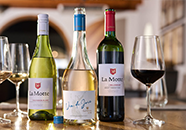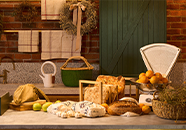
Jacob Hendrik Pierneef was born in Pretoria on this day (13 August) in 1886. Honoured as one of South Africa’s greatest and most famous landscape artists, he is recognised as the master interpreter of the South African landscape and it was in this field that he gained the most fame.
At La Motte we have a great admiration for the creativity of Pierneef as witnessed by the extensive collection of Pierneef art displayed in the La Motte museum and on the estate and, as a tribute to him, the depiction of his linoleum cuts on the labels of our premium wine range, the Pierneef Collection.
Pierneef’s creativity in portraying the beauty of the South African landscape and architecture has also served as a model for Pierneef à La Motte restaurant’s creativity in offering cuisne inspired by centuries of variation in cooking, a unique presentation known as Cape Winelands Cuisine.
Pierneef’s Life
In his early life Pierneef received little formal education in art, but during the family’s temporary stay in Holland, during the Anglo-Boer War, he enrolled as a student at the Academy of Art in Rotterdam, Academia Erasmiana. Soon, he showed brilliant drawing skills and started attending classes in oil-painting techniques presented by Frans Oerder and received etch technique training from the Irish graphic artist George Smithard. He also had a close relationship with Anton van Wouw, his godfather, and Hugo Naudé, who was his constant inspiration.
Pierneef died in Pretoria on 4 October 1957.
Excellence in lino cuts

Boabab (Baobab)
Pierneef was a master in the art of painting. Through his technical drawing skills and extraordinary ability in line and form he was, however, also a superior graphic artist – his wood and lino cuts are regarded as being of equal importance as his paintings.
In the nineteenth century linoleum was generally used as a floor covering. During later years, German artists used it in creating works of art based on the principal of print graphics. Using this technique, the design (matrix) is engraved on a flat surface in relief by means of specially designed cutters with various blade forms. The surface is then covered with printing-ink and the design reproduced on paper or textile.
Pierneef’s lino cuts cover a number of themes, from historic and famous buildings, farmsteads, wine cellars and landscapes, to his favourite subject, indigenous trees. He was also well-known for his portrayals of majestic cloud formations rising behind houses or mountain cliffs. Furthermore, Pierneef created lino cut designs for magazines, volumes of poetry, programmes, catalogs for his own exhibitions and various ex libris. In his approach to art, he firmly guarded against following European tendencies and styles – he was dedicated to developing his own unique style.
Pierneef’s acquaintance with La Motte
The lino cut collection at La Motte consists of a set of 128 prints, reproduced in a limited number after Pierneef’s death. For each of his three children the late Dr Anton Rupert bought a set, the eighth of which is the La Motte set that belongs to Hanneli Rupert-Koegelenberg.
A new chapter was opened with the display of these lino cuts on the back labels of La Motte’s premium wine range, the Pierneef Collection. Each new vintage is depicted by a different Pierneef lino cut.

The Pierneef Collection of wines
During negotiations regarding copyright for the display of these lino cuts on labels, a friendship developed between Pierneef’s daughter, Marita Bailey-Pierneef, and Hanneli Rupert-Koegelenberg and her husband Hein and a few years later Marita made her art legacy available to La Motte. At present, it can be viewed as a permanent exhibition in the La Motte Museum.

The Pierneef exhibition in the La Motte Museum
This Pierneef collection consists of 44 originals from the period 1908 to 1955 and represents various mediums used by Pierneef, such as oil, water-colour, gouache, pen-and-ink sketches as well as crayon and charcoal sketches.

Pienk Wolke, 1929 (Pink Clouds, 1929)
The collection is of great sentimental value and includes Pierneef’s easel, brushes, portfolio and precious books and personal photographs.

Pierneef’s easel and brushes
Pierneef’s wish:
“Begrawe my onder ‘n kameeldoringboom, met sy reguit manlike karakter bo my en sy wortels diep in die Afrikaanse grond ingedring …”
“Bury me under a camelthorn tree, with its straight, manly character guarding me and its roots deep in the soil of Africa … ”
From PG Nel; Pierneef His life and his work, p. 108












